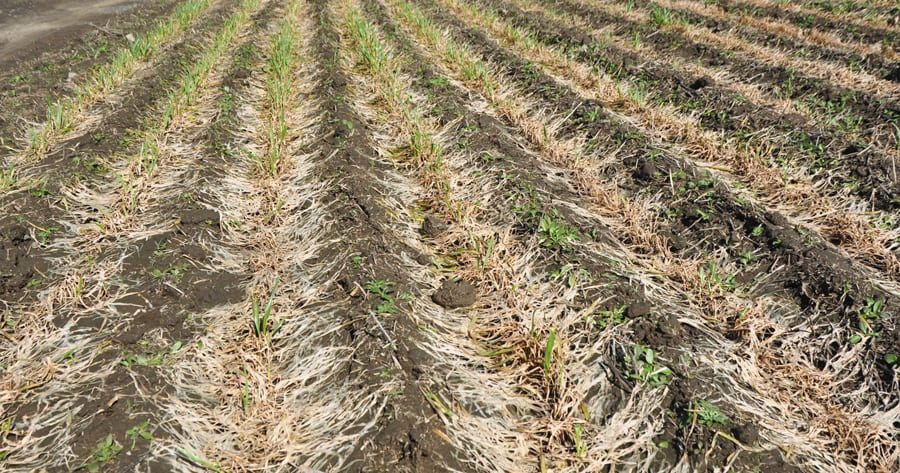
Home » Pink snow mold damages region’s wheat fields
Pink snow mold damages region’s wheat fields

April 13, 2017
Benton, Franklin county wheat farmers more concerned about late start to growing season
Though a damaging snow mold has been spotted in some Eastern Washington wheat fields, local farmers aren’t expressing concern.
Pink-tinged mold in fields of winter wheat and even in lawns of grass in southcentral and southeastern Washington has experts and farmers keeping a close watch.
But in Benton and Franklin counties, farmers say they are more anxious about the late start to the growing season because of the winter’s extreme weather.
Franklin County wheat farmers reported seeing the pink mold in conservation reserve program, or CRP, land and waste lands, but it has not been spotted in the wheat yet, said Michelle Hennings, executive director of the Washington Association of Wheat Growers.
Caused by the fungus Microdochium nivale, the mold attacks perennial plants and overwintering crops.
Benton County farmers have seen some on side hills receiving a lot of snow that took a long time to melt, and also in CRP land, but nothing of concern, Hennings said.
“They are more concerned about being behind in field work but they are behind in growing,” she said.
CRP land is administered by the Farm Service Agency. In exchange for yearly rental payment, farmers enrolled in the program agree to remove environmentally-sensitive land from agricultural production and grow species to improve environmental health and quality.
There were no major concerns about snow mold or stripe rust voiced during a March wheat association board meeting in which updates were given from each county, Hennings said. The statewide wheat association has 1,546 members.
“Snow actually protects the wheat from harsh and cold weather. The downfall with a lot of snow is the snow mold in certain areas of the state. Stripe rust comes with an abundant amount of moisture,” Hennings said.
Important state commodity
Wheat is the state’s fifth top commodity, worth $600 million, behind apples, milk, cattle and potatoes, Hennings said. Washington farmers produced 157.2 million bushels of wheat last year.
Total wheat farming employment equals 6,860 jobs statewide.
For every dollar in revenue generated by wheat farming, 73 cents are earned by businesses supporting farmers. Off-farm purchases by farmers and their employees add 28 cents more for a total of $1.01 in economic activity beyond farmers’ own sales, mostly in small towns where agriculture serves as a crucial anchor for businesses, Hennings said.
Snow mold uncommon here
Melting snow has exposed patches of injured wheat in parts of the state where destruction by snow mold is rarely seen, said WSU plant pathologist Tim Murray, who has studied the fungus for nearly four decades. He recently met with 20 growers in the town of Prescott to address their concerns about the mold’s effect on winter wheat.
“Growers in this area have never seen this mold until now,” he said. “Its presence may have surprised me, but it really surprised them.”
After examining a half-dozen fields in southcentral and southeastern Washington, Murray identified winter wheat damage ranging from nonthreatening lesions on leaves to underground crown decay that kills the plant.
“I was surprised to see how prevalent the damage was in some of the fields,” he said. “We’ll definitely be seeing some economic damage as a result.” He stressed that the extent can’t be tallied until soils are warm enough to reveal which plants could withstand the damage and which could not.
A cold-loving organism that thrives under long periods of snow cover, so-called pink snow mold is more commonly seen in the higher elevations of northcentral Washington where snow blankets the ground for 100 days or more.
But this winter’s pervasive snowy weather fueled the mold’s growth in lower elevations as well, said Murray, including in Walla Walla, Whitman and Columbia counties.
“Snow protects winter wheat and other dormant plants from cold temperatures, which is a good thing,” he said. “But the snow cover becomes a problem when it stays on the ground for too long, which is just what happened.”
In areas where the fungal disease is evident, snow had covered the ground 60 to 70 days. Although longer than most years, “it’s still not long enough to cause the kind of damage I’ve been seeing. It typically takes at least 100 days,” Murray said.
Abnormally warm temperatures in November kept the ground from freezing before the first hard snow arrived, creating a more hospitable environment for Microdochium nivale to grow. That, coupled with a longer-than-usual period of snow cover, gave it just what it needed to thrive.
“The fungus is out there. As we’ve seen, when the weather allows it to take advantage of the situation, it does,” he said.
Growers advised to wait
Murray has spent 40 years helping to develop high-quality wheat varieties that mount a defense reaction against snow mold and other diseases that plague the crop in cold climates. Microdochium nivale is one of three fungi that cause snow mold in Washington.
Murray advises growers to let a few weeks of warmer weather pass to assess the full impact of damage in their fields. At that point, they can decide whether reseeding will be necessary.
More information about Washington wheat can be found at 2016/2017 WA Wheat Facts.
Local News
KEYWORDS april 2017




